- Polka Dot Begonia: What Can You Do To Keep This Plant Healthy? - September 14, 2021
- Ficus Microcarpa: Why Is This A Must Have Plant? - September 13, 2021
- Begonia Ferox: How Long It Takes For Begoniaceae To Sprout? - August 24, 2021
If you love unique plants, you will love this most picturesque plant, Polka Dot Begonia (Begonia maculate). This Begonia can add drama and color to indoor areas as a popular and stunning houseplant. It boasts spectacular rusty-red undersides, featuring wing-shaped, bronze-green leaves. The leave tops are teasingly adorned in silver spots, and it gets its name from its variegation.
You can decorate your tabletops and desks with the beautiful Polka Dot Begonia when young. Then, as the plant ages, you will have a stunning floor plant that reaches about four feet or even more with good care. Even though the primary reason for growing Polka Dot Begonia is its variegated leaves, the plant can also display clusters of small, tiny white flowers throughout the year if you adorn it with adequate light.
Pro tip: you can grow Polka Dot Begonia as an annual outdoors in containers and shaded gardens.
How to Identify Polka Dot Begonia
When it comes to flowering plants, Begonia boasts one of the largest genera. As a diverse genus, it prides itself on having more than 1,800 various natures of perennial species. Begonias are natives to the subtropical and tropical parts of South Asia, America, and Africa, and growers use them as indoor and outdoor plants.
The main feature of these plants is unique, colorful, and bright foliage. In addition, they can grow bisexual, single-petal, and petal-less flowers. Several growers have extensively hybridized Begonias to create a wide range of plant varieties. Moreover, they have not wholly discovered with various species queuing for description.
When it comes to Polka Dot Begonia, the plant is getting enough attention. With that, it has many common names, including:
- Spotted Begonia
- Trout Begonia
- Polka Dot Begonia
- Clown Begonia
- Angelwing Begonia
Polka Dot Begonia grows up to about 60 inches in height, and each mature leaf grows on the scale of 20 to 25 cm in size. Its flowers are about three to five inches long with angelic white flower clusters that enhance this peep beauty in the summer or spring warm days. The flowers boast four to seven solid petals, bright yellow centers while growing on bamboo-like thorny stems.
When you grow it correctly, these pants can produce small flowers similar to other Begonias. Unfortunately, Polka Dot Begonia may not be safe for pets and even humans when ingested. However, the plant is air purifying. It prefers dappled or indirect, bright sunlight.
How to Grow Polka Dot Begonia From Seed
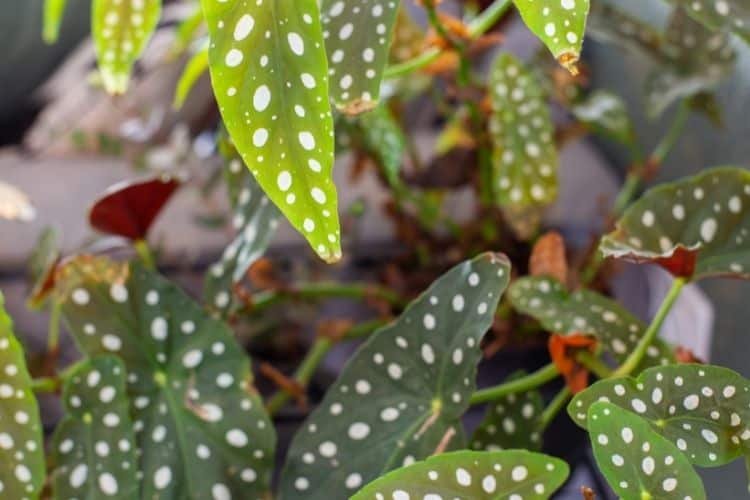
When you want to plant Polka Dot Begonia from seed, you will have to start the seeds indoors about ten to twelve weeks before the last frost. First, use pre-moistened soil to surface-sow them.
Next, use a peat-based seed mix to sow the seeds. Prepare a milled sphagnum moss light dusting to cover them and use a slight mist to moisten the moss. Then, use little water when placing the flat in a tray and cover with clear plastic. You will notice the seedlings growing on some days at room temperature.
Some growers water their seeds before planting them since the seeds and the soil can float out of the container when they water afterward.
The plant tolerates 70 degrees to 75 degrees F for optimal temperature. To quicken germination, use a heat mat. You should notice germination within one to two weeks. If you also see that the cotyledons tend to be solid green, don’t be discouraged. These are the initial leaves that will fall off when the plant’s true leaves begin to grow. These true leaves you are expecting will be multi-colors.
Essentially, you can transplant into six-packs or individual containers when the second true leaves appear. Use liquid fertilizer to feed it every week. Next is to move them into larger containers after seedling for about two months.
Even though Polka Dot Begonia can’t tolerate direct sunlight, it can become bushier in fluorescent or high indirect light conditions. Fertilize or water the plant as much as you would any annuals.
How to Propagate Polka Dot Begonia
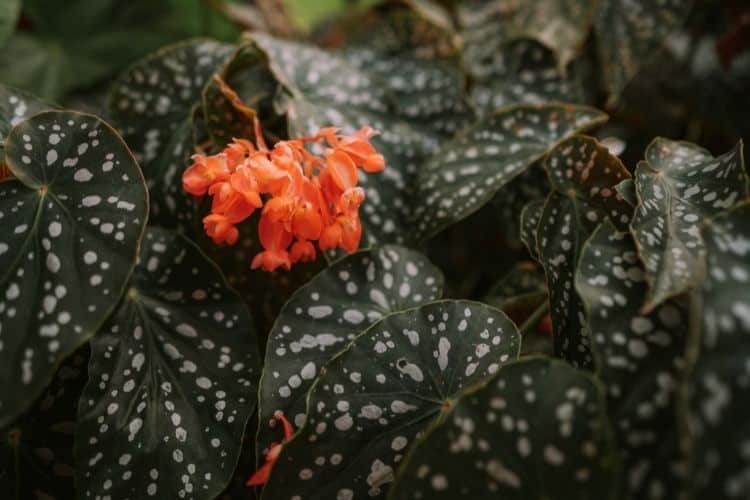
While you can plant your Polka Dot Begonia from seeds, the most rewarding means of grow the plant is through cuttings propagation. When making a new Polka Dot begonia from cuttings, you only need to snip some fresh leaves from the plant.
Use a sharp and clean knife to divide the leaves into neat wedges after laying them flat upside down. Take more caution when using a razor blade. Ensure that each wedge piece has a vein, and when you use this method, it is easy to make several baby Begonia plants. However, there is no need to slice up the leaves when you need a few new plants.
Start by snipping some leaves from the main plant without touching about one inch of petiole attached to each leaf. It is helpful to know that the petiole is the stalk that attaches the leaf to the plant’s stem and extends from the leaf.
The next step is to use well-draining soil to sill a small pot to make a nursery for your leaf cuttings. We recommend using a mixture of perlite, peat, or vermiculite moss. Stick the petiole stalks or the leaf wedges into the moss or soil and prepare a plastic bag in a warm and bright place away from direct sunlight to store the pot.
Ensure that there is some water in the potting soil to keep your cuttings moist. However, avoid overwatering as it could lead to rot. Allow three to four weeks to start seeing roots from the planting time. Essentially, your baby plant will be ready, and you can move it to your preferred garden or pot after six weeks.
Alternatively, you can even propagate your cuttings in a clean and fresh glass of water to make new Polka Dot Begonias. The perfect propagation type size for this is the food jars. With a single jar, you can have many cuttings. In addition, you can transfer your cuttings to new pots when the roots are around half an inch long.
Propagation from Stem Cuttings
Polka Dot Begonia can grow from stem cuttings, typically referred to as rhizomes. Growers use these long thick stems under the soil when growing them. You can begin the process by cutting one-inch length of a rhizome piece and placing it into a mix of moss or a well-draining soil pot.
The plant is like its leaf counterparts that must not be wet but moist. Take it away from direct sunlight until you notice the roots forming in around five to seven weeks while keeping it in a well-lit, warm place.
Polka Dot Begonia Growing Conditions
Polka Dot Begonia requires 65 to 86 degrees temperatures every two to four weeks of fertilization, well-aerated soil that dries a bit between watering and bright, indirect light. While the plant tends to be relatively easy to propagate, Polka Dot Begonia needs semi-regular pruning and is fussy about humidity.
It is no wonder that Polka Dot Begonia needs consistent moisture and intense, warmth-filtered light as an evergreen perennial. However, the plant is also a reasonably fast grower that can reach three feet with cascading white flowers year-round.
The plant’s thick stems cannot tolerate wet conditions and hold some water as a cane Begonia. Polka Dot Begonia also wants its topsoil drying out between watering.
One of the crucial things to the plant is light. However, the humidity factor is Polka Dot Begonia’s secret care. Steamy settings mimic the plant’s native habitat. Growing Polka Dot Begonia doesn’t entail building a greenhouse for the plant. However, there will be a need to allow some humidity to keep the plant happy and fresh. You surely don’t want a sad clown, Begonia!
Another critical factor is proper potting. While the plant enjoys being rootbound, it can wear out its soil in close quarters. Therefore, the best practice is yearly repotting, even if it means taking it back to the same pot.
If you want a beautiful plant, you will need to be careful grooming and pruning Polka Dot Begonia. The plant’s simple propagation process is one good trait of this angelic-winged species. Growing a new plant tends to be easier than keeping a grown one happy.
How to Plant Polka Dot Begonia
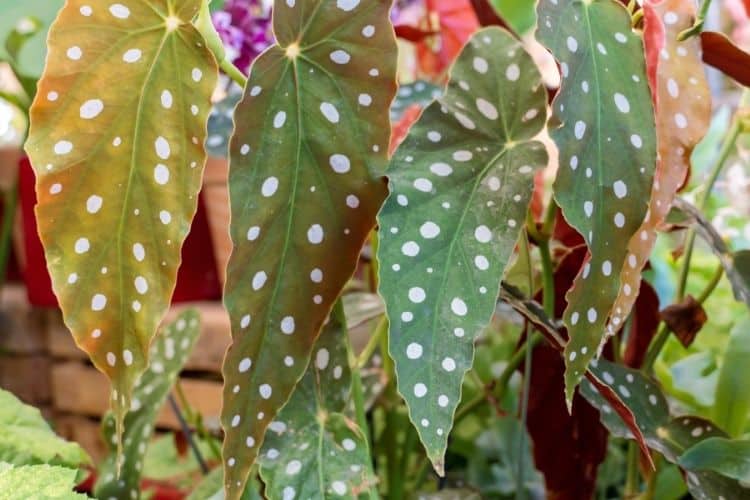
With the plant’s broad angel wing-molded leaves dotted with a rich purple-red on the base and polka dots on top, Polka Dot Begonia is indeed a real eye-catcher! Something exceptional about this plant is that it is easy to care for it as a houseplant. You don’t need to impress with a green thumb with this plant.
It is also a relatively fast-growing plant that makes a fabulous terrarium plant or indoor houseplant.
Polka Dot Begonia Potting & Soil
Polka Dot Begonia prefers moist soil. As such, a soil mix that can retain water pretty well is necessary. A palm soil mix can maintain moisture well without compacting after you water Polka Dot Begonia a few times. Thus, the way to go for your plant is using palm soil mix.
The plant also likes well-draining soil that can hold moisture without becoming soggy. Light commercial mixes are perfect for the plant. However, we recommend mixing these amendments if you want ideal conditions for your Polka Dot Begonia:
- A small quantity of inorganic fertilizer or compost will be a significant addition. Ensure to adhere to the product recommendation; it is enough to have a half-handful pot. Anyway, the plant will require light fertilization as this will only bolster fertility.
- Wood chips – non-toxic wood chips can aid aeration with just a sprinkle. The soil will receive a welcome space with the angular chips. While the chips can decompose, you have nothing to worry about since you will frequently refresh and repot your Polka Dot Begonia.
- Perlite – perlite is almost Styrofoam-textured material with fluffy tiny white balls that are indeed volcanic glass. They play a significant role in insulating the soil from rapid temperature change and keeping it light and well-aerated. We want you to be careful not to mix vermiculite with perlite, as vermiculite can retain too much moisture.
A light commercial potting soil will be the starting point. Next, apply lesser wood chips and a few handfuls of perlites until you notice a fluffy, springy mix. You will need more for the future season. So, mix more. Keep it sterile and fresh by storing it in an airtight container.
Polka Dot Begonia Water Requirements
It can be tricky to water your Polka Dot Begonia, except you have the right soil type. We will discuss this right soil type shortly. However, let’s first go over the rules.
Polka Dot Begonia prefers moist soil all the time without giving it a drought. The plant prefers you water it again after the top half-inch of its soil has dried out completely. You may have to deal with root rot by keeping the plant too wet. As such, refrain from watering when you have moist soil.
You can also discourage nuisance pests like gnats or fungus by keeping the topsoil dry. Polka Dot Begonia doesn’t tolerate wet leaves. Therefore, we recommend you water the plant from the bottom. You can avoid the plant’s large leaves when you are careful.
Constantly examine the plant’s soil and water the soil thoroughly when you notice that the topsoil is dry. Polka Dot Begonia also prefers a break between watering, and you need to ensure that the plant never wilt.
Polka Dot Begonia Light Requirements
Polka Dot Begonia favors a strong sunlight bright spot. Direct rays may burn the foliage or even fade the silvery spots. During the winter months, the plant will prefer a southern exposure. The acceptable year-round is the west or east windows if you keep your plant away from direct light. The goal to ensure you achieve is bright filtered light.
Essentially, low light will be perfect for the plant if necessary. However, very dim quarters may sadden the plant. If you are a Southern grower, you may want to consider this plant a shade variety. The gardeners in colder regions can place their plants in bright windows with limited direct afternoon or morning sun.
Polka Dot Begonia’s leaves will inform you whether the plant is not getting enough light. The plant’s leaves may start to shed after losing some color. When they are getting too much, you will notice scorched parts on the leaves.
Best Polka Dot Begonia Fertilizers
We recommend fertilizing your Polka Dot Begonia every two weeks with diluted liquid houseplant fertilizer to encourage more prominent blooms and healthy leaves. You can also use water-soluble fertilizer’s half the required dosage for the best results. Therefore, you can use two cups when the package indicates one cup of water to dilute the solution.
Polka Dot Begonia is a moderate feeder even under high light. As such, the plant can be pretty easy to feed. However, do not overdo it, or you may have to deal with brown edges and tips on those fancy leaves. Ensure not to fertilize the plant in winter and fall. Let it rest. You can eliminate the flowers when they are done blooming. With that, the plant can flower again.
Best Polka Dot Begonia Companion Plantings
Big Daddy Hosta
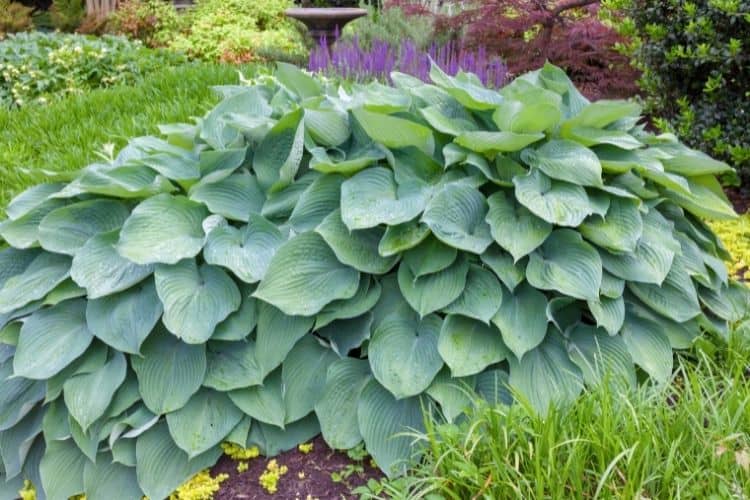
Big Daddy Hosta will make a perfect combination with Polka Dot Begonia with its blue leaves to set the stage for the classic color combination. This plant is a blue, large-leaved hosta that grows to 40-inches wide and 28-inches tall in a mound. Big Daddy Hosta boasts rugose, cupped, thick, round, and rich blue leaves with cordate bases and mucronate tips.
While the shade instigates the best blue foliage color, the plant has tolerance for some brief morning sun. When grown in shady conditions, the leaves can retain bright color throughout the growing season. However, they can age to green as summer commences.
Light Requirements
Dappled or filtered sunlight is critical for healthy, clean growth. The plant can tolerate the morning sun as it will aid the leaf color intensity.
Soil Requirements
Big Daddy Hosta thrives well in highly organic, well-drained, and moist soils with 5.5 and 7.5 pH. It also prefers sandy loam to clay since it offers more aeration for the roots.
Water Requirements
It is essential not to overfeed or overwater the plant. The plant’s growing season requires moist soil without overwatering it.
Pros
- The plant can grow everywhere
- Some Hostas are fragrant
- The plant comes in various colors
- Hostas fit anywhere
- The plant is drought tolerant
Cons
- The foliage attracts snails and slugs
- Crown rot
- Leaf spots
- Rabbits and deer can eat the leaves
Fanal Astilbe
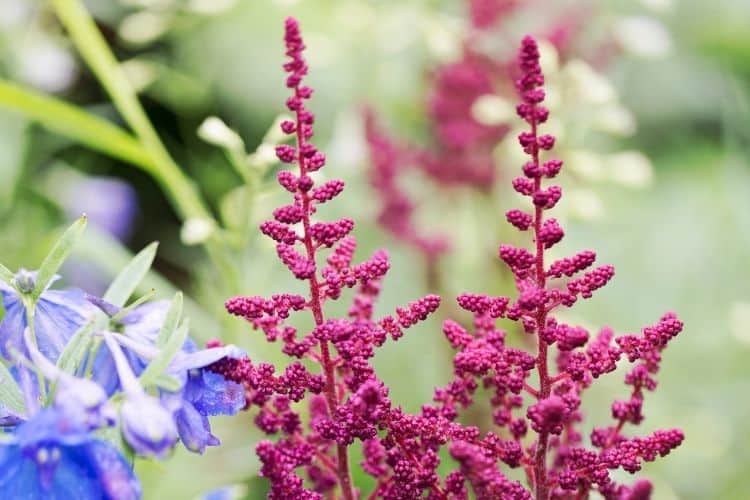
Fanal Astilbe can form a clean, crisp, and classic combination with Polka Dot Begonia with its feathery, tall garnet-red blooms prized for its airy, light quality. The plant has narrow, full, dark crimson red plumes that are stunningly rising on top of beautiful bronze foliage in early to mid-summer.
The plant has several densely packed small flowers in each plume with succession in each opening, offering a long-lasting bloom season. The foliage will have a reddish tint as it turns dark green with the commencement of each summer.
Light Requirements
Growers can plant it in full sun with adequate moisture and cool summers. However, one of the essential requirements for this plant is shade.
Soil Requirements
The plant prefers and grows well in well-drained, acidic, evenly moist, and organically rich soil, placed in filtered sun or bright shade. Fanal Astible has no tolerance for dry conditions.
Water Requirements
Water this plant deeply every week, particularly in the time of dry, summer weather. Fanal Astible can even die, and the foliage will brown when allowed to dry out. As such, the plant cannot tolerate soggy soils. Therefore, it is essential not to overwater.
Pros
- The plant can light up a neglected section of the yard
- It radiates with plume-like flowers with glowing, rich colors
- Some varieties have sweetly fragrant
- Add interest and texture to cut-flower arrangements and container gardens
Cons
- Clump, bushy forming
- A slow-spreading plant
Candidum Caladium
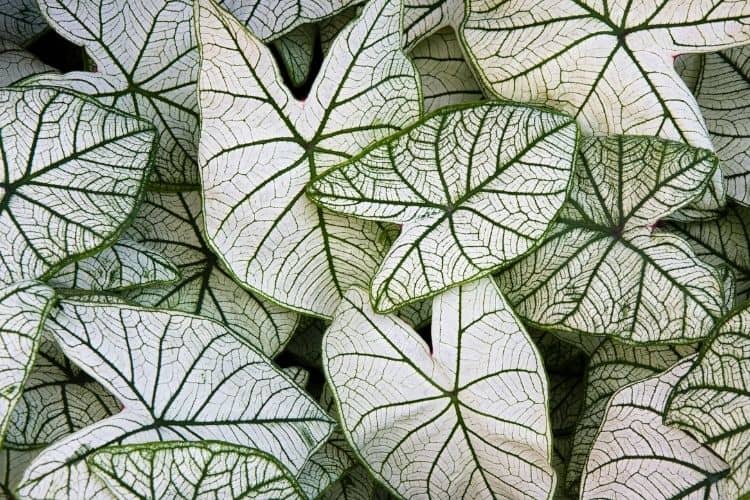
You can create a fresh appearance by combining the gold and white foliage plant of Candidum Caladium with Polka Dot Begonia. Caladium Candidum is reputed for its highly decorative leaves as a tuberous perennial with white, heart-shaped, and lush leaves endowed with striking dark green veins. Calla-type, inconspicuous blooms emerge in summer.
However, the leaves typically hide them. This brilliant foliage Candidum is striking to add drama and color to containers or shady borders while growing in full shade. The plant also makes a beautiful houseplant.
Light Requirements
Caladium thrives best in part shade or shade, preferably bright dapped light or about four hours of morning direct sunlight to produce colorful, large leaves with the lushest growth.
Soil Requirements
The plant favors well-drained soil rich in organic matter like chopped leaves or mushroom compost.
Water Requirements
Water Caladium Candidum once or twice a week to keep the soil slightly moist based on weather conditions.
Pros
- Generally, pest and disease-free
- Excellent in containers, borders, or shaded beds
- Requires little maintenance
Cons
- Direct sun can scorch the leaves
- Requires regular moisture
- Snails and slugs can invade the plant
- Requires warm water to plant in spring
Polka Dot Begonia Diseases and Common Problems
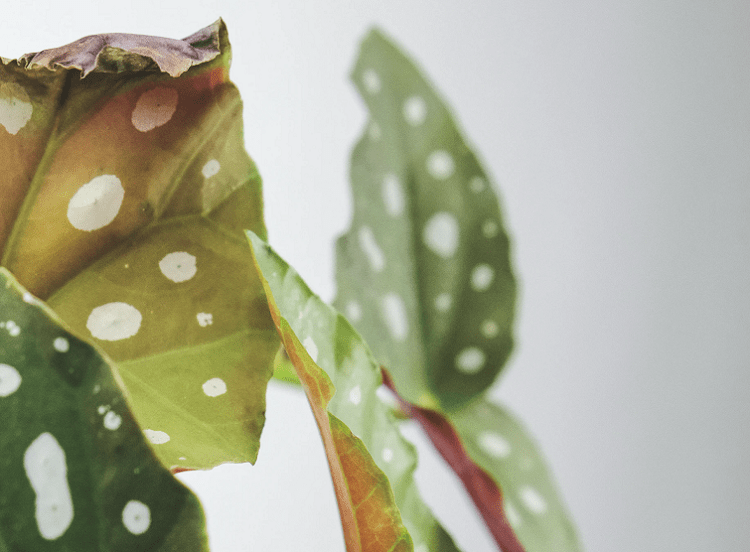
We recommend reading through this section carefully because your chances of having a successful Polka Dot Begonia plant depend on how well you understand different issues affecting it. Therefore, pay close attention.
A short dormancy period may lead to a lack of flowers with the same temperatures for an extended period. With less irrigation, you can cut back on the warmth by a few degrees over the winter and autumn months. With this, you can determine a well-spent dormancy. Apply supplements in early summer leading up to possible buds using a potassium-based fertilizer.
It is not a threat when you notice sheath casing browning since it is an entirely natural process that can affect all specimens worldwide. You can detach the brown part when it becomes crispy and dry. Then, peel back the browned tissue using your hands and enhance its entire appearance.
Spider mites are near-transparent, small critters. They will gradually extract the leaves’ chlorophyll. First, check under the plant’s foliage, especially close to the midribs. Look for gritty yellow bumps or small webs. As such, remove any flowers with severely affected stems or leaves. Next, use a moist cloth to rub both sides of the leaves with more attention to the under-leaves where they can lay their eggs and webs.
Ensure to clean Polka Dot Begonia leaves always. Even though it is a simple task, you must learn to do it because dust particles’ buildup will clog your plant’s pores, leading to reduced light-capturing efficiency. However, you can improve the plant’s growing conditions and keep down the levels by rinsing the leaves’ topsides once a month.
Polka Dot Begonia can have browning leaf tips and yellow halos through severe dry air. You can prevent new growth from adopting these symptoms by increasing humidity, even though this issue may not kill your plant. Present a better growing condition by creating a humidity tray or mist every week while putting on the heaters.
Crispy brown parts across the plant’s foliage can happen due to persistent droughts. Then, use a pair of scissors to removes the affected leaves after leaving them to thoroughly brown over. Don’t puncture the soft tissue because it can cause bacterial diseases. Start using a pebble tray or a watering schedule to the future avoid dehydration risk.
Polka Dot Begonia may become leggy after some time. Fret not because any establishing specimen will have this normal behavior. Promote a bushier appearance by pruning back the sample to a third, getting stem cuttings from pruning.
Let their bottom halves root after placing them in water for about eight weeks. The next stage is to increase the number of leaves closer to the soil by putting these roots into the mother plant’s container when they are more than 3 cm.
A clear overwatering sign is when older leaves become yellow quickly. Too little light can also cause symptoms like a rotten base, stunted growth, and heavy or moldy soil. It will help if you reduce the irrigation frequency to counteract the root rot chance, even though the plant can thrive well in darker locations.
Many growers are not aware that the root system of any plant requires access to oxygen, too; the air can travel out of the potting mix and upwards when they water the soil. They can break down subsequently over the coming days through a lack of accessible oxygen.
Polka Dot Begonia Treatments and Maintenance
Maintaining your Polka Dot Begonia and giving it the best treatments is easy. You can give your plant a boost in the sun by taking it outdoors, particularly during summer. Alternatively, it is not wrong to keep the plant indoors throughout the year.
Essentially, ensure to bring your plant indoors before it gets too cold when you want to take it outside for a bit of sun. Polka Dot Begonia can wilt and die when exposed to frost since they cannot tolerate frost.
When the temperature falls below 60 degrees Fahrenheit, we recommend bringing it back indoors. The plant cannot withstand cold temperatures, and such sudden change will be too much for it. Bring them indoors to survive and thrive beautifully.
Where to Buy Polka Dot Begonia Seeds Online
Polka Dot Begonia is available only at:
Where to Buy Mature Polka Dot Begonia Online
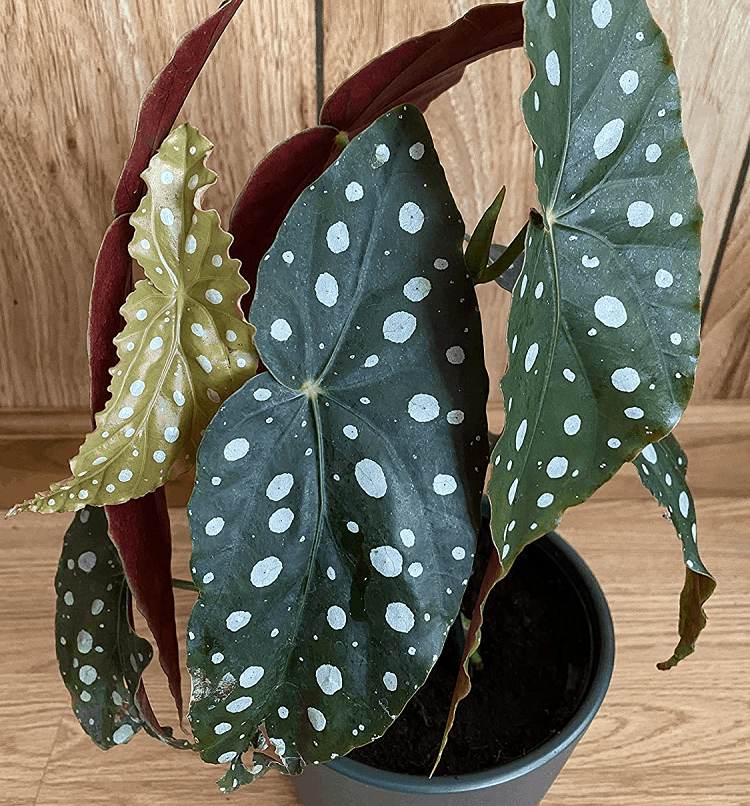
These retailers sell mature Polka Dot Begonia online:

